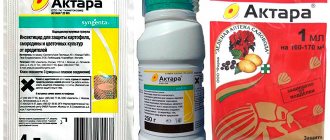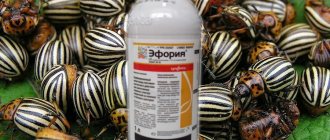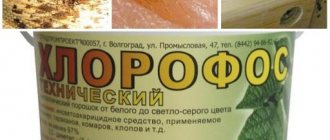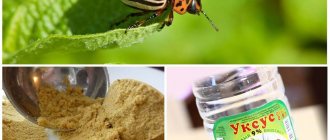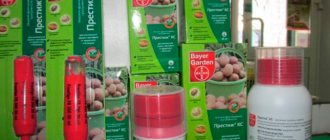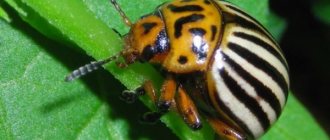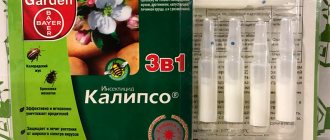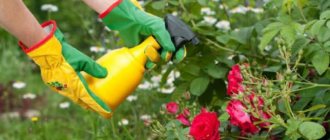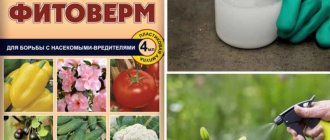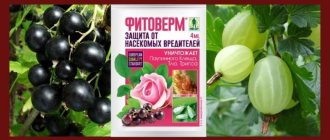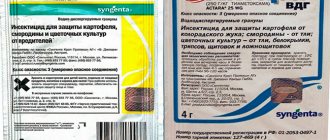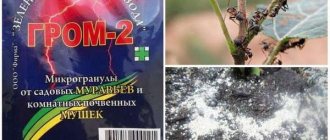Author: Elena N. https://floristics.info/ru/index.php?option=com_contact&view=contact&id=19 Category: Insecticides Published: December 11, 2011Republished: February 11, 2019Last edits: March 12, 2021
In search of a drug that will get rid of pests in your garden, flower garden and beds, you will definitely come across Aktara. This is the first remedy that will be recommended to you both on forums on the Internet, and by sellers of specialized stores, and by neighbors in the country: Aktara will help you solve almost all gardening problems, effectively destroying both colorados on potatoes and scale insects on orchids. However, an experienced and careful owner of the site will probably think about what kind of catch might be hidden behind such enthusiastic advertising. Is Aktara really not afraid of rain? How can you use this drug to protect seedlings from pests even before they are planted in the ground? In this article we will try to answer in detail the most important questions about the use of Aktara.
Content
- Purpose and application
- Composition and dosage form
- Mechanism of action
- Application regulations
- b) Regulations for the use of the insecticide “Aktara, KS, VDG” for agricultural production
- Restrictions and security
- Compatibility
- Analogues of "Aktara"
- Advantages and disadvantages
"Aktara" is a contact-intestinal pesticide. The material includes the purpose, composition, release format, mechanism of action, regulations for use, restrictions, etc.
Purpose and application
The drug "Aktara" is used in private household plots and agriculture in both open and protected ground conditions. The use of the drug is part of a set of protective measures for treating greenhouses.
The action of the drug "Aktara" is aimed at protecting:
- potatoes - from soil pests and the Colorado potato beetle;
- tomatoes, cucumbers and other vegetable crops - from aphids, whiteflies, thrips;
- cabbage - from fleas and flies;
- peas - from pea moth, pea weevil, pea aphid;
- onions – from tobacco thrips and onion fly;
- flower crops and seedlings - from thrips, scale insects and false scale insects, soil flies and fungus gnats;
- grain crops - from the harmful bug, ground beetle;
- grapes, apple trees, pears - from copperheads, leafhoppers, flower beetles:
- and many more others.
When applied to the soil, Aktara has pronounced systemic activity, that is, it simultaneously protects against soil and ground pests.
Line of insecticides "Aktara, VDG" (water-dispersible granules)
What is it for?
The main purpose of the drug is to combat:
- thrips;
- whiteflies;
- scale insects;
- scale insects;
- false scale insects;
- Colorado potato beetle;
- aphids, which parasitize berry and vegetable gardens.
Suitable for processing indoor flowers. Effective against adult parasites, pupae, eggs, larvae.
Composition and dosage form
The basis of the drug is the active substance TIAMETHOXAM , from the class of neonicotinoids.
Release format:
a) “Aktara, VDG” , water-dispersible granules, dosage 250g/kg, packaged in 40g, 250g. and 1kg. and in small packages of 1g., 4g.;
b) “Aktara, KS” , suspension concentrate, dosage 240 g/l., packaged in 1 liter. and ampoules of 1 ml., 1.2 ml., 9 ml.
Insecticide "Aktara, KS" (liquid) for private household plots
Manufacturer Syngenta AG, Switzerland - a company producing plant protection products and seed material. Registrant in the Russian Federation LLC “Syngenta”
First aid for drug poisoning:
If the drug gets into your eyes, rinse immediately with plenty and thoroughly of running water. In case of contact with skin, wipe off the product with a clean cloth and immediately wash with soap.
If the drug is accidentally swallowed, give several glasses of water with charcoal to drink, and then induce vomiting.
There is no specific antidote for the drug. Shelf life of the drug: The drug is in a closed package for 4 years from the date of manufacture.
The chemical composition consists of thiamethoxane. Its color is cream, the crystals have no odor. It dissolves well in water.
It is available in vacuum bags.
The contents of the package are granules. They are applied directly to the soil or can be made into a solution for spraying plants. Pests die within 24 hours. The first results can be seen within 30–60 minutes.
There is also a can type of packaging in stores. Usually they are 250 grams. This type is not recommended for home flowers. One vacuum packaging will be enough. But if you want to treat the entire garden, buy an Aktary glass jar.
Important: 1 gram of the drug can be used for 230–250 flower pots. It is used in any weather conditions, at any time of the year. Its components are not susceptible to radiation from sunlight, and are unchanged by fluctuations in air humidity
It also works well in combination with other drugs and supplements.
It is used in any weather conditions, at any time of the year.
Its components are not susceptible to radiation from sunlight, and are unchanged by fluctuations in air humidity. It also works well in combination with other drugs and supplements.
The components penetrate slowly, and therefore the plant will be protected for a long time.
It can also be used as a prophylactic. Its main advantage is that it is practically harmless to animals.
Mechanism of action
The insecticide "Aktara" according to the method of penetration is a contact-intestinal pesticide of systemic action.
So, the speed of impact is only a few hours after treatment. The period of protective action is 14–21 days when spraying the crop, 40–60 days when applied in soil.
The active substance is quickly absorbed by the plant and moves through the vascular system of the plant to the untreated parts. Once in the insect's body, thiamethoxam acts on the nicotinic acetylcholine receptors of the nervous system, causing the insect to stop feeding and subsequently die.
According to research, the metabolite of thiamethoxam is clothianidin, which has a high rate of exposure to harmful organisms and persistence in plants and soil.
General information about the drug Aktara
Aktara insecticide belongs to the group of neonicotinoids with contact-intestinal action. It can be used to treat not only fruit trees, but also garden soil. This eliminates the possibility of the development of pest larvae, whose life cycle involves being in the ground. The prolongation of Aktar's properties increases to 2 months. The pesticide is characterized by the rapid action of the main substance - thiamethoxam: insects, their larvae and eggs begin to die within the first days after treating the plants.
Aktar release forms
The drug is absolutely harmless to soil microorganisms, earthworms, and birds. It does not cause parasites to become addicted to the active substance, so gardeners can use this effective remedy every year. When the pest gets on the body, thiamethoxam begins to show its toxic properties within half an hour. The insecticide is able to penetrate through the surface of leaves into the cell sap of plants. By eating poisoned green mass, pests are exposed to toxic substances of the drug through the digestive system.
First, the receptors in the insect's intestinal tract are suppressed, which is why it can no longer feed, and then the toxins act psychotropically. The pest’s nervous system is blocked, and a little later paralysis and death occur. Aktara is available in the form of tablets, granules, powder and suspension. Economical packaging makes it possible to rationally use the drug for treating small gardens on personal plots and large areas of industrial gardening. Insecticide cost:
| Dosage | Price in rubles |
| 3 ml | 104 |
| 4 g | 199 |
| 1.2 ml | 46 |
| 250 g | 4500 |
| 9 ml | 239 |
| 1 l | 10000 |
Application regulations
The drug is used in two ways:
- spraying the vegetative parts of the plant;
- application under the root with irrigation water, including using drip irrigation systems.
a) Regulations for the use of the insecticide “Aktara, KS, VDG” for private farms
| Culture | Pest | Consumption rate "Aktara, KS" | Consumption rate "Aktara, VDG" | Working fluid flow | Features of treatments | Frequency of treatments | Waiting period |
| Aphids, thrips, whiteflies, scale insects, false scale insects, soil flies, fungus gnats | 1 ml/10 l. water | 1 gr./ 10 l. water | up to 10 l./ 10 m² (250 pots) | Watering the soil under plants during the growing season, with a plant height of up to 30 cm. | 1 | — |
| Colorado beetles | 0.6 ml. / 100 m² | 0.6 g/ 100 m² | up to 5 l./ 100 m² | Spraying during the growing season | 1 | 14-20 |
| Aphid | 2 ml/10 l water | 2 gr. / 10 l. water | up to 1.5 l./bush | 1st time - spraying before flowering, 2nd time after harvesting | 2 | 60 |
| Aphids, whiteflies, thrips, scale insects and false scale insects | 8 gr. / 10 l. water | up to 1 l./ 10 m² | Spraying during the growing season when pests appear | 2-3 | — |
b) Regulations for the use of the insecticide “Aktara, KS, VDG” for agricultural production
Dosages, consumption rates, frequency and features of treatments (download below):
- grapes;
- tomatoes, cucumbers, peppers and other vegetable crops in protected ground;
- grain crops;
- onions, etc.
How to breed
Treatment must be carried out in sunny, windless weather so that the substance does not spread to other plants. If you are going to apply the substance to indoor plants, make sure it is safe. Cats and dogs can knock over the flower, the substance itself can cause intestinal disorders, because a large concentration is used. Therefore, it is better to close such a room or room with plants and open the windows slightly.
"Aktara" for flowers and crops is used only if you find a pest (mite, beetle). In other (for prevention) situations it is not required.
The solution must be distributed in advance, since then the remaining opened bag can only be thrown away. Calculate how much you will need to use the substance. It is recommended to apply it on the day on which the solution was diluted. The container should be shaken before use. Consider the instructions for use for indoor plants:
- Take a container that can hold up to 5 liters of water in advance. It should not leak, and the sprayer itself should be in good working order (spraying with small streams of water, not drops). Granules of the substance are poured into a container and filled with warm water in the open air. The granules must be mixed.
- It is often difficult to find such a large container in the house, then you can distribute a bag of the substance into four equal piles (approximately 1 gram each). For one pile 1.2 liters of water. All this must be done on newspaper or other material while wearing gloves. You can pour it into the sprayer in portions, then shake it.
- It is recommended to treat indoor plants outdoors, as all the substance will settle in your room.
Restrictions and security
Hazard class for humans - class 3.
When working with insecticide, you should use PPE and follow personal safety standards. In case of poisoning, seek medical advice. help.
Hazard class for bees - class 1. When processing, the border protection zone for bees must be at least 5 km. A ban has been established on the use of the drug "Aktara" in the sanitary zones of fisheries and its use by air.
Soil resistance class – 2nd class. The question of the possibility of using pasture grasses for animal feed after treatment with the drug "Aktara" is subject to consideration by state veterinary control authorities.
Precautionary measures
The drug belongs to the 3rd hazard class, which characterizes it as a moderately dangerous substance.
When working with the drug, it is necessary to observe generally known protective measures:
- isolate children and animals during treatments;
- do not eat, smoke, or use food utensils during work;
- use personal protective equipment, glasses, a respirator;
- Avoid ingestion; if necessary, if you feel unwell, consult a doctor;
- work no more than 3 hours;
- The prepared solution cannot be stored; any remaining working solution should be disposed of with household waste or burned, and should not be poured into sewers or water bodies.
Advantages and disadvantages
a) Advantages of the drug "Aktara":
- A wide range of effects on a complex of common insects - plant pests (sucking and gnawing), including soil-dwelling and secretive ones.
- The effect of the drug does not depend on weather conditions, it retains its effect at high temperatures and low humidity, including rain resistance.
- The drug is non-selective and non-phytotoxic for plants in recommended applications.
- It is characterized by a high speed of initial impact and a long period of protective action.
b) The disadvantages include:
- The drug is resistant, therefore, to eliminate resistance to the insecticide, it is recommended to alternate with insecticides of other chemical classes.
- "Aktara" is ineffective against lepidopteran pests.
Compatibility with other drugs
"Aktara" is well compatible with other drugs. The only one who doesn't tolerate friendship well is drugs with an alkaline reaction.
But you can mix them if there is a very strong need:
If you choose “Fetoverm” and “Aktara”, then it is better not to mix them, but to process them sequentially in dry form at a temperature of no more than +16 ° C.
"Fitospirin" can be combined, but very carefully. Gardeners recommend doing this if you need to quickly get rid of pests.
If you add Aktara to Fufanol, the second will expand the range of actions of the first. There are even ready-made mixtures of similar effects on sale.
If you mix with bacterial preparations, then you must definitely reduce the consumption rates. Otherwise, you may burn the plant.
And remember, it is better to mix under the guidance of an experienced gardener. It is not recommended to do such actions on your own.
